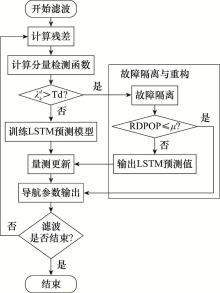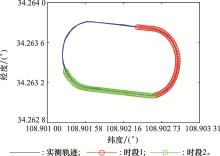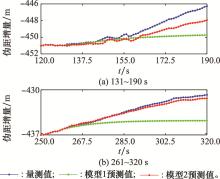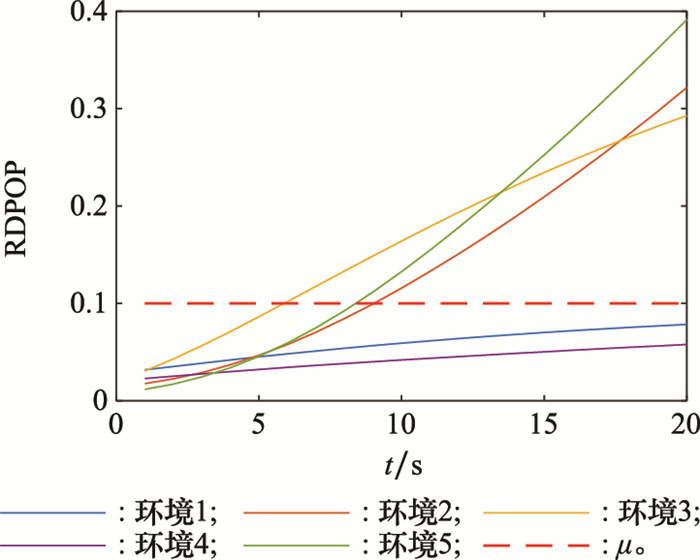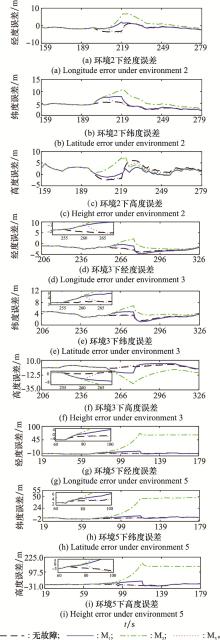Systems Engineering and Electronics ›› 2023, Vol. 45 ›› Issue (3): 831-838.doi: 10.12305/j.issn.1001-506X.2023.03.25
• Guidance, Navigation and Control • Previous Articles Next Articles
Adaptive fault-tolerant method based on long-short term memory neural network
Zihan SHEN1, Xiubin ZHAO1,*, Chuang ZHANG2, Liang ZHANG1, Xinxian LIU1
- 1. Information and Navigation College, Air Force Engineering University, Xi'an 710077, China
2. Unit 95510 of the PLA, Guiyang 550029, China
-
Received:2022-02-23Online:2023-02-25Published:2023-03-09 -
Contact:Xiubin ZHAO
CLC Number:
Cite this article
Zihan SHEN, Xiubin ZHAO, Chuang ZHANG, Liang ZHANG, Xinxian LIU. Adaptive fault-tolerant method based on long-short term memory neural network[J]. Systems Engineering and Electronics, 2023, 45(3): 831-838.
share this article
Table 4
Positioning error of each method during fault existing period m"
| 环境 | 维度 | M1 | M2 | M3 |
| 环境2 | 经度 | 2.407 | 3.202 | 0.216 |
| 纬度 | 1.927 | 2.901 | 0.255 | |
| 高度 | 1.316 | 4.989 | 0.679 | |
| 环境3 | 经度 | 1.413 | 2.713 | 0.537 |
| 纬度 | 0.940 | 1.809 | 0.350 | |
| 高度 | 6.088 | 11.542 | 1.546 | |
| 环境5 | 经度 | 4.082 | 20.169 | 0.814 |
| 纬度 | 1.823 | 8.964 | 0.740 | |
| 高度 | 17.245 | 49.609 | 3.146 |
| 1 | 罗凯鑫, 吴美平, 范颖. 基于最大熵方法的鲁棒自适应滤波及其应用[J]. 系统工程与电子技术, 2020, 42 (3): 667- 673. |
| LUO K X , WU M P , FAN Y . Robust adaptive filtering based on maximum entropy method and its application[J]. Systems Engineering and Electronics, 2020, 42 (3): 667- 673. | |
| 2 |
PAN W C , ZHAN X Q , ZHANG X , et al. A subset-reduced method for FDE ARAIM of tightly-coupled GNSS/INS[J]. Sensors, 2019, 19 (22): 4847.
doi: 10.3390/s19224847 |
| 3 | 张闯, 赵修斌, 庞春雷, 等. LS-SVM辅助的小幅值及缓变故障检测与容错方法[J]. 中国惯性技术学报, 2019, 27 (3): 415- 420. |
| ZHANG C , ZHAO X B , PANG C L , et al. LS-SVM assisted fault detection and tolerance method for small-amplitude fault and gradual fault[J]. Journal of Chinese Inertial Technology, 2019, 27 (3): 415- 420. | |
| 4 | JIANG W , LIU D , CAI B G , et al. A fault-tolerant tightly coupled GNSS/INS/OVS integration vehicle navigation system based on an FDP algorithm[J]. IEEE Trans.on Vehicular Technology, 2019, 68 (99): 6365- 6378. |
| 5 | DU S , GAN X D , ZHANG R Q , et al. The integration of rotary MEMS INS and GNSS with artificial neural networks[J]. Mathe-matical Problems in Engineering, 2021, 2021, 6669682. |
| 6 | 苏敬, 何华锋, 何耀民, 等. 考虑SAR量测特性的弹载SINS/SAR组合导航滤波算法[J]. 系统工程与电子技术, 2021, 43 (4): 1044- 1049. |
| SU J , HE H F , HE Y M , et al. Filtering algorithm of missile-borne SINS/SAR integrated navigation considering SAR mea-surement characteristics[J]. Systems Engineering and Electro-nics, 2021, 43 (4): 1044- 1049. | |
| 7 | SHEN C , XIONG Y F , ZHAO D H , et al. Multi-rate strong tracking square-root cubature Kalman filter for MEMS-INS/GPS/polarization compass integrated navigation system[J]. Mechanical Systems and Signal Processing, 2022, 163 (1): 108146. |
| 8 | 王巍, 邢朝洋, 冯文帅. 自主导航技术发展现状与趋势[J]. 航空学报, 2021, 42 (11): 525049. |
| WANG W , XING C Y , FENG W S . Sate of the art and perspectives of autonomous navigation technology[J]. Acta Aeronautica et Astronautica Sinica, 2021, 42 (11): 525049. | |
| 9 | 孙淑光, 温启新. 基于高程异常补偿的飞机终端区组合导航高度优化算法[J]. 系统工程与电子技术, 2021, 43 (9): 2612- 2619. |
| SUN S G , WEN Q X . Aircraft height optimization algorithm of integrated navigation in terminal area based on height anomaly compensation[J]. Systems Engineering and Electronics, 2021, 43 (9): 2612- 2619. | |
| 10 |
陈莹超, 熊继军, 周兆英, 等. 基于短期数据融合的自主三维导航系统[J]. 仪表技术与传感器, 2017, 2017 (1): 130- 133. 130-133, 138
doi: 10.3969/j.issn.1002-1841.2017.01.033 |
|
CHEN Y C , XIONG J J , ZHOU Z Y , et al. Independent 3D navigation system based on short-term data fusion[J]. Instrument Technology and Sensors, 2017, 2017 (1): 130- 133. 130-133, 138
doi: 10.3969/j.issn.1002-1841.2017.01.033 |
|
| 11 | ZHANG C, ZHAO X B, PANG C L, et al. Improved fault detection and tolerance method based on local test and adaptively robust filtering for INS/GNSS integration[C]//Proc. of the IEEE Chinese Control and Decision Conference, 2019: 5919-5924. |
| 12 | 董毅, 王鼎杰, 吴杰. 载波相位时间差分辅助的SINS/GNSS紧组合导航方法[J]. 中国惯性技术学报, 2021, 29 (4): 451- 458. |
| DONG Y , WANG D J , WU J . MEMS-based SINS/GNSS tightly-coupled navigation aided by time-differenced carrier-phase measurements[J]. Journal of Chinese Inertial Technology, 2021, 29 (4): 451- 458. | |
| 13 | NAGAI K, SPENKO M, HENDERSON R, et al. Evaluating INS/GNSS availability for self-driving cars in urban environments[C]//Proc. of the International Technical Meeting of the Institute of Navigation, 2021: 243-253. |
| 14 | YAO Y Q , XU X S , ZHU C C , et al. A hybrid fusion algorithm for GPS/INS integration during GPS outages[J]. Mea-surement, 2017, 103, 42- 51. |
| 15 | ZHANG C , ZHAO X B , PANG C L , et al. The influence of satellite configuration and fault duration time on the perfor-mance of fault detection in GNSS/INS integration[J]. Sensors, 2019, 19 (9): 2147. |
| 16 | TEUNISSEN P . Distributional theory for the DIA method[J]. Journal of Geodesy, 2018, 92 (1): 59- 80. |
| 17 | ZHANG C , ZHAO X B , PANG C L , et al. Adaptive fault isolation and system reconfiguration method for GNSS/INS integration[J]. IEEE Access, 2020, 8, 17121- 17133. |
| 18 | WANG L H , ZHI K Y , LI B , et al. Dynamically adjusting filter gain method for suppressing GNSS observation outliers in integrated navigation[J]. Journal of Navigation, 2018, 71 (6): 1396- 1412. |
| 19 | 苗岳旺, 周巍, 田亮, 等. 基于新息χ2检测的扩展抗差卡尔曼滤波及其应用[J]. 武汉大学学报, 2016, 41 (2): 269- 273. |
| MIAO Y W , ZHOU W , TIAN L , et al. Extended robust Kalman filter based on innovation chi-square test algorithm and its application[J]. Geomatics and Information Science of Wuhan University, 2016, 41 (2): 269- 273. | |
| 20 | 胡晓月, 康凯, 钱骅, 等. 基于LSTM的LEO卫星链路自适应算法[J]. 系统工程与电子技术, 2021, 43 (1): 237- 243. |
| HU X Y , KANG K , QIAN H , et al. Link adaptation algorithm based on LSTM network for LEO satellite[J]. Systems Engineering and Electronics, 2021, 43 (1): 237- 243. | |
| 21 | WANG B , LIU S C , WANG B , et al. Multi-step ahead short-term predictions of storm surge level using CNN and LSTM network[J]. Acta Oceanologica Sinica, 2021, 40 (11): 104- 118. |
| 22 | LI B , LIANG S Y , CHEN D Q , et al. A decision-making method for air combat maneuver based on hybrid deep learning network[J]. Chinese Journal of Electronics, 2022, 31 (1): 107- 115. |
| 23 | ZHOU H , ZHOU Y H , HU J J , et al. LSTM-based energy management for electric vehicle charging in commercial-building prosumers[J]. Journal of Modern Power Systems and Clean Energy, 2021, 9 (5): 1205- 1216. |
| 24 | CHANG Y Z , WANG Y Q , SHEN Y Y , et al. A new fuzzy strong tracking cubature Kalman filter for INS/GNSS[J]. GPS Solutions, 2021, 25 (3): 120. |
| 25 | ZHANG C , ZHAO X B , PANG C L , et al. Improved fault detection method based on robust estimation and eliding window test for INS/GNSS integration[J]. Journal of Navigation, 2020, 73 (4): 776- 796. |
| 26 | ZAMINPARDAZ S , TEUNISSEN P J G . DIA-datasnooping and identifiability[J]. Journal of Geodesy, 2019, 93 (2): 85- 101. |
| 27 | CHEN C C , ZHANG Q , KASHANI M H , et al. Forecast of rainfall distribution based on fixed sliding window long short-term memory[J]. Engineering Applications of Computational Fluid Mechanics, 2022, 16 (1): 248- 261. |
| 28 | MOUATADID S , ADAMOWSKI J F , TIWARI M K , et al. Coupling the maximum overlap discrete wavelet transform and long short-term memory networks for irrigation flow forecasting[J]. Agricultural Water Management, 2019, 219 (1): 72- 85. |
| 29 | ZHANG G H , XU P H , XU H S , et al. Prediction on the urban GNSS measurement uncertainty based on deep learning networks with long short-term memory[J]. IEEE Sensors Journal, 2021, 21 (18): 20563- 20577. |
| 30 | WANG J , JIANG W P , LI Z , et al. A new multi-scale sliding window LSTM framework (MSSW-LSTM): a case study for GNSS time-series prediction[J]. Remote Sensing, 2021, 13 (16): 3328. |
| 31 | KASELIMI M , VOULODIMOS A , DOULAMIS N , et al. A causal long short-term memory sequence to sequence model for TEC prediction using GNSS observations[J]. Remote Sensing, 2020, 12 (9): 1354. |
| 32 | 王鑫, 吴际, 刘超, 等. 基于LSTM循环神经网络的故障时间序列预测[J]. 北京航空航天大学学报, 2018, 44 (4): 772- 784. |
| WANG X , WU J , LIU C , et al. Exploring LSTM based recurrent neural network for failure time series prediction[J]. Journal of Beijing University of Aeronautics and Astronautics, 2018, 44 (4): 772- 784. | |
| 33 | 李世玺. 一种基于混沌理论和LSTM的GPS高程时间序列预测方法[J]. 导航定位学报, 2020, 8 (1): 65- 73. |
| LI S X . A GPS height time series prediction method based on chaos theory and LSTM[J]. Journal of Navigation and Posi-tioning, 2020, 8 (1): 65- 73. |
| [1] | Xiaowei WANG, Yafeng ZHAN, Haoran XIE, Xi CHEN. A preliminary study on the design of constellation orbiting the moon with the communication and navigation integration [J]. Systems Engineering and Electronics, 2023, 45(1): 241-249. |
| [2] | Pu ZHANG, Huifeng XUE, Shan GAO, Xuan ZUO. Distributed finite-time adaptive cooperative fault-tolerant control for multi-agent systems with integrated actuators faults [J]. Systems Engineering and Electronics, 2022, 44(4): 1220-1229. |
| [3] | Xing LIU, Wenshuang WANG, Jianyin ZHAO, Min ZHU. Research on an adaptive online incremental ELM fault diagnosis model [J]. Systems Engineering and Electronics, 2021, 43(9): 2678-2687. |
| [4] | Min ZHU, Qi LIU, Xing LIU, Qing XU. Fault detection method for avionics based on LMKL and OC-ELM [J]. Systems Engineering and Electronics, 2020, 42(6): 1424-1432. |
| [5] | XIE Haoyu, QIU Jing, YANG Peng. Testability index allocation method considering unit mutual test [J]. Systems Engineering and Electronics, 2019, 41(12): 2899-2904. |
| [6] | XU Zhaoxin, LI Hangzhou, LI Liang, ZHAO Lin, LIU Ya. EKF/SF-based short-baseline BDS multipath mitigation method [J]. Systems Engineering and Electronics, 2017, 39(6): 1334-1340. |
| [7] | MA Long, DAI Chaofan, PEI Xin, HUANG Chao, ZHANG Hongyan, SU Zhigang. Fault detection method for redundant configuration of MEMS gyroscope [J]. Systems Engineering and Electronics, 2017, 39(10): 2298-2304. |
| [8] | ZHAO Lin, ZHANG Sheng-zong, LI Liang, WANG Xue. BDS/GPS integrated precise point positioning based on adaptive extended Kalman filter [J]. Systems Engineering and Electronics, 2016, 38(9): 2142-2148. |
| [9] | LIU Xing-chuan, WU Zhen-feng, ZHAO Ke-jian. Algorithm for faulttolerant topology control in heterogeneous and multi-hop wireless sensor networks [J]. Systems Engineering and Electronics, 2015, 37(8): 1902-1908. |
| [10] | ZHAO Yu-xin, CHANG Shuai, WAN Cheng-cheng. Software reliability growth model considering fault detection effort and fault correction effort [J]. Systems Engineering and Electronics, 2015, 37(4): 969-973. |
| [11] | FENG Li-yuan, YAO Xu-liang, CAO Ran, ZOU Ai-li. Reliability and safety analysis of repairable control method based on distributed systems [J]. Systems Engineering and Electronics, 2015, 37(11): 2663-2668. |
| [12] | WANG Jiawei, SHEN Yi, WANG Zhenhua. Fault detection for nonlinear switched systems using unknown input observers [J]. Systems Engineering and Electronics, 2015, 37(10): 2322-2328. |
| [13] | CHEN Fu-rong, YIN Yan-yan, LIU Fei. Robust fault detection of Markovian jump systems with partly#br# unknown transition probabilities [J]. Systems Engineering and Electronics, 2014, 36(9): 1819-1825. |
| [14] | LIU Cong, LI Ying-hui. Design of high-gain observers with sliding mode for the actuator robust fault detection of nonlinear system [J]. Systems Engineering and Electronics, 2014, 36(8): 1626-1631. |
| [15] | QIAN Hua-ming,PENG Yu,CUI Mei,FU Zhen-duo. Design of robust fault detection observer for uncertain systems based on LMI [J]. Systems Engineering and Electronics, 2014, 36(6): 1162-1168. |
| Viewed | ||||||
|
Full text |
|
|||||
|
Abstract |
|
|||||


